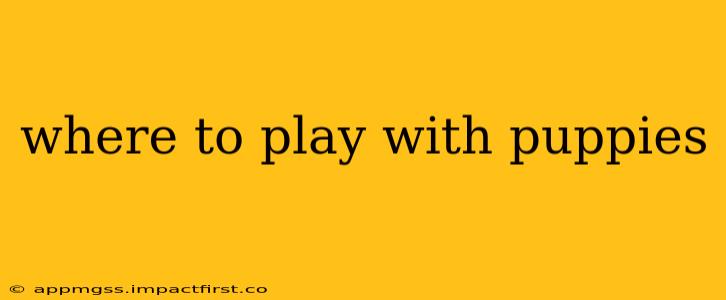Finding safe and stimulating places to play with your puppy is crucial for their development and socialization. Puppyhood is a vital time for learning and building positive experiences. This guide explores various locations and considerations for ensuring your puppy has fun, safe playtime.
What are the best places to play with puppies?
The best place to play with your puppy depends on their age, vaccination status, temperament, and your access to resources. Let's explore some options:
1. Your Own Backyard (Fully Enclosed and Secure): A fenced-in backyard is ideal for supervised puppy playtime. It provides a controlled environment where your puppy can explore, run, and play without the risks associated with public spaces. Make sure the fence is secure, with no gaps or areas your puppy can escape through.
2. Dog Parks (with Caution): Dog parks can be excellent socialization opportunities, but use caution. Choose parks known for responsible dog owners and well-behaved dogs. Ensure your puppy is fully vaccinated before introducing them to a dog park to minimize the risk of infectious diseases. Always supervise your puppy closely and be ready to intervene if needed.
3. Puppy Classes: Puppy classes provide a structured environment for socialization and learning basic obedience. These classes are led by experienced trainers who can guide you on proper puppy play and training techniques. They’re a great way to help your puppy learn appropriate social behavior with other dogs.
4. Private Playdates: Arrange supervised playdates with other puppies or dogs whose temperaments and vaccination statuses you know. This allows for controlled interaction and helps build positive social skills.
5. Quiet, Safe Indoor Spaces: When the weather is bad or your puppy needs a break from outdoor play, your home provides a safe and controlled environment. Use toys and interactive games to keep your puppy entertained and stimulated.
What should I avoid when choosing a place to play with my puppy?
1. Public Parks Without Fences: Public parks without fences expose your puppy to significant risks, including traffic, other animals (both friendly and not), and potential hazards.
2. Crowded Areas: Overly crowded areas can be overwhelming and stressful for puppies. Excessive stimulation can lead to fear, anxiety, or unwanted behaviors.
3. Areas with Potential Hazards: Avoid areas with potential dangers such as busy roads, construction sites, or areas with poisonous plants.
4. Dog Parks with Aggressive Dogs: If you encounter an aggressive dog or owner, remove your puppy immediately and avoid that park in the future.
How do I ensure safe puppy playtime?
Safe puppy playtime requires constant supervision, appropriate play equipment, and awareness of potential risks.
- Always Supervise: Never leave your puppy unsupervised, even for a short time, in any play area.
- Appropriate Toys: Provide age-appropriate toys that are safe and durable.
- Monitor Interactions: Observe interactions closely, intervening if necessary to prevent aggression or rough play.
- Cleanliness: Clean up after your puppy promptly, leaving the play area tidy.
- Vaccination Status: Ensure your puppy is fully vaccinated before exposing them to public spaces.
- Hydration: Bring water for your puppy, especially during warmer weather.
What kind of toys are best for puppy play?
Choose sturdy, durable toys appropriate for your puppy's size and chewing habits. Avoid toys that are easily broken into small pieces that could be swallowed. Rope toys, plush toys (with appropriate supervision), and chew toys are all good options.
How often should I play with my puppy?
Puppies need regular playtime for both physical and mental stimulation. Aim for several short play sessions throughout the day, gradually increasing the duration as your puppy gets older and their stamina improves. Remember, short, frequent play sessions are generally better than one long session. Balance playtime with rest and training.
By following these guidelines, you can ensure your puppy has safe, fun, and enriching playtime experiences, setting them up for a happy and well-adjusted life. Remember to always prioritize your puppy's safety and well-being.
